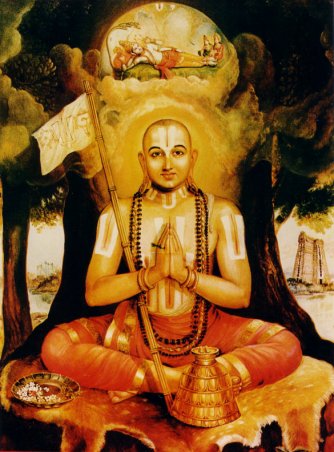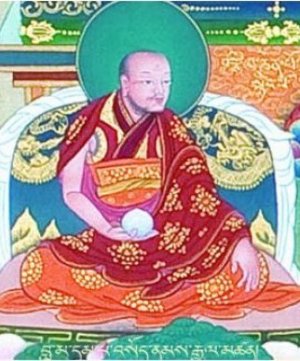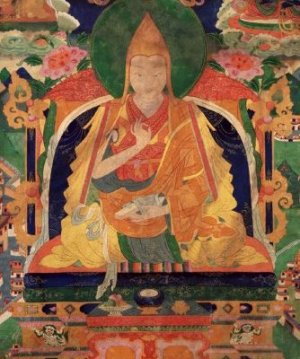| Library / Biographies |
Rāmānujā Biography

Śri Rāmānujā, pioneer of Viśiṣṭādvaita Vedānta and the foremost saṃnyāsin of Śri Vaiṣṇava Saṃpradāya.Rāmānujā was considered the first thinker in centuries that disputed Śaṅkara's theories and offered an alternative interpretation of Upanishadic scriptures.
His Viśiṣṭādvaita (qualified non-dualism) philosophy has competed with the Dvaita (theistic dualism) philosophy of Madhvāchārya, and Advaita (non-dualism) philosophy of Ādi Śaṅkara, together the three most influential Vedantic philosophies of the 2nd millennium.
His followers wrote hagiographies, some of which were composed centuries after his death, and which the tradition believes to be true.
However, scholars question their reliability because of claims which are impossible to verify, or whose historical basis is difficult to trace.
The traditional hagiographies of Rāmānujā state he was born to mother Kānthimathi and father Asuri Kesava Somayāji, in Śrīperumbūdur, near modern Chennai, Tamil Nādu.
They place his life in the period of 1017–1137 CE, yielding a lifespan of 120 years.
These dates have been questioned by modern scholarship, based on temple records and regional literature of 11th- and 12th-century outside the Śri Vaiṣṇava tradition, and modern era scholars suggest that Rāmānujā may have lived in 1077–1157 CE.
In his teenage years Rāmānujā married, moved to Kāñcīpuram and studied in an Advaita Vedānta monastery with Yādava Prakāśa as his guru, who had strong affinities to Śaṅkara’s Absolute Idealistic Monism (Advaita Vedānta).
Rāmānujā and his guru frequently disagreed in interpreting Vedic texts, particularly the Upanishads.
Over time, Yādava Prakāśa grew jealous of Rāmānujā's rise to fame and found his skill at offering alternative interpretations threatening to his authority and the popularity of his philosophy. He even planned to assassinate Rāmānujā while on a group pilgrimage. But Rāmānujā found out through his cousin Govinda and was able to escape.
After further disagreements Rāmānujā separated from his guru and thereafter continued his studies on his own. Later in his life Yādava Prakāśa became a disciple under Rāmānujā.
Rāmānujā attempted to meet Yamunāchārya, another famed Vedanta scholar of 11th-century, leader of Śrī Vaiṣṇava Sampradāya, who was near the end of his life and in search of a successor. Śrī Vaiṣṇava tradition holds that Yamunāchārya died before the meeting.
One hagiography states that after leaving guru Yādava Prakāśa, Rāmānujā was initiated into Śri Vaiṣṇavism by Periya Nambi, also called Mahāpūrṇa, the senior disciple of Yamunāchārya. Rāmānujā renounced his married life and became a saṃnyāsin.1
Rāmānujā became a priest at the Varadharāja Perumal temple (Viṣṇu) at Kānchipuram, where he began to teach that moksha (liberation and release from samsara) is to be achieved not with metaphysical, nirguṇa Brahman but with the help of personal god and saguṇa Viṣṇu.
Rāmānujā has long enjoyed foremost authority in the Śri Vaiṣṇava tradition.
He helped the people who were considered to be untouchables (dasa, dasulu, dasu), to get absorbed into the Śri Vaiṣṇava Bhakti Movement, encouraging them to attain Spiritual enlightenment by teaching them Śri Alwar Divyaprabandham, a collection of 4,000 Tamil verses composed by the 12 Alvars.2
Rāmānujā's liberal views also led to the reorganization of rituals and the involvement of non-brahmin people in the Vaiṣṇava worship. This policy change contributed to the enhancement of social status for artisanal and other non-brahmin caste groups.
After the period of Rāmānujā, the Śri Vaiṣṇava community split on this issue and formed the Vadakalai (northern and Sanskritic) and Thenkalai (southern and Tamil) sects.
Both sects believe in initiation into Śri Vaiṣṇavism through Pancha Samskara. This ceremony or rite of passage is necessary for one to become a Śri Vaiṣṇava Brahmin. It is performed by Brahmins and non-Brahmins in order to become Vaiṣṇavas.
Rāmānujā reformed the Srirangam Ranganathaswamy temple complex, undertook India-wide tours, participated in public debates with adepts of rival schools and expanded the reach of his organization.
The temple organization became the stronghold of his ideas and his disciples. It is here that he wrote his influential Viśiṣṭādvaita philosophy text, Śri Bhāṣyam.
Rāmānujā organized a network of temples for Viṣṇu-Lakṣmī worship and set up centers of studies for his philosophy, by traveling through India in that era. These influenced generations of poet saints devoted to the Bhakti movement.
The birthplace of Rāmānujā near Chennai hosts a temple and is an active Viśiṣṭādvaita school. His monastery and temple traditions are carried on in the most important and large Vaiṣṇava centres – the Ranganātha temple in Srirangam, Tamil Nadu, and the Venkateswara Temple, Tirumala in Tirupati, Andhra Pradesh.
The mummified body of Rāmānujā is preserved at the Ranganathaswamy Temple in Srirangam using sandalwood paste and saffron.
Writings
The Śri Vaiṣṇava tradition attributes nine Sanskrit texts to Rāmānujā:
• Vedārthasaṃgraha (literally, "Summary" of the "Vedas meaning");
• Śri Bhāṣya (a review and commentary on the Brahma Sutras);
• Bhagavadgītā Bhāṣya (a review and commentary on the Bhagavadgītā );
• Vedāntadipa (Light on Vedanta);
• Gadya Trayam (poems of Surrender), which is a compilation of three texts called the Saranāgati Gadyam (The Large Poem of Surrender), Sriranga Gadyam (The Smaller Poem of Surrender to Lord Ranganatha) and the Vaikunta Gadyam (The Poem of Contemplation on Vaikuntha);
• Nitya Grantham (Manual of Daily Worship).
Some scholars have questioned the authenticity of all but the three of the largest works credited to Rāmānujā – Śri Bhāṣya , Vedārthasaṃgraha and the Bhagavadgītā Bhāṣya .
Disciples
• Swami Mudaliyandan; he was a nephew of Sri Rāmānujā, the codifier of the philosophy of Śri Vaiṣṇavism;
• Koorathazhwan; also known as Kuresa and Srivatsanka Mishra, was the chief disciple of Rāmānujā;
• Kidambi Aachan;
• Thirukurugai Piran Pillan;
• Nadadhur Azhwan;
• Anantazhwar.
Sources
• https://ramanuja.org
• https://en.wikipedia.org
• https://iep.utm.edu/ramanuja/
Footnotes
1. Rāmānujā decided to separate from his wife due to her caste discrimination. Once she had a fight with Mahāpūrṇa’s wife who belonged to a lower Brahmanic caste. Another time she had an attitude towards Rāmānujā’s childhood mentor, a member of a lower caste. The latter incident prompted the separation.
2. The alvars were Tamil poet-saints of South India who espoused bhakti (devotion) to the Hindu god Viṣṇu in their songs of longing, ecstasy and service. They are venerated especially in Vaiṣṇavism, which regards Viṣṇu as the Supreme Being.





